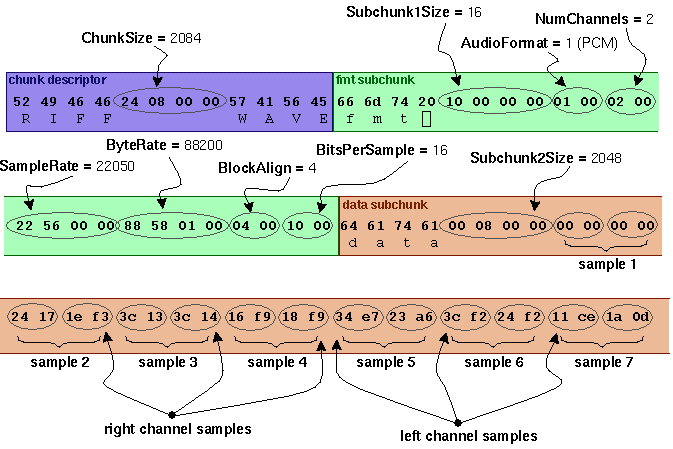1.PCM Wave格式详解
WAVE文件格式是微软RIFF(Resource Interchange File Format,资源交换文件标准)的一种,是针对于多媒体文件存储的一种文件格式和标准。 一般而言,RIFF文件由文件头和数据两部分组成,一个WAVE文件由一个“WAVE”数据块组成,这个“WAVE”块又由一个"fmt"子数据块和一个“data”子 数据块组成,也称这种格式为“Canonical form”(权威/牧师格式),如下图所示:

每个字段的涵义如下: ChunkID: 占4个字节,内容为“RIFF”的ASCII码(0x52494646),以大端(big endian)存储。 ChunkSize: 4字节,存储整个文件的字节数(不包含ChunkID和ChunkSize这8个字节),以小端(little endian)方式存储。 Format: 4字节,内容为“WAVE”的ASCII码(0x57415645),以大端存储。
其中bigendian 主要有一个特征,在内存中对操作数的存储方式和从高字节到低字节。例如:0x1234,这样一个数,存储为:
0x4000: 0x12
0x4001: 0x34
而小尾端littleendian是:
0x4000: 0x34
0x4001: 0x12
用程序在区别的话,可以考虑:
``` c
#include
"WAVE"格式由两个子数据块构成:“fmt”块和“data”块,其中“fmt”块的详细解释如下: Subchunk1ID: 占4个字节,内容为“fmt ”的ASCII码(0x666d7420),以大端存储。 Subchunk1Size: 占4个字节,存储该子块的字节数(不含前面的Subchunk1ID和Subchunk1Size这8个字节),以小端方式存储。 AudioFormat:占2个字节,以小端方式存储,存储音频文件的编码格式,例如若为PCM则其存储值为1,若为其他非PCM格式的则有一定的压缩。 NumChannels: 占2个字节,以小端方式存储,通道数,单通道(Mono)值为1,双通道(Stereo)值为2,等等。 SampleRate: 占4个字节,以小端方式存储,采样率,如8k,44.1k等。 ByteRate: 占4个字节,以小端方式存储,每秒存储的bit数,其值=SampleRate * NumChannels * BitsPerSample/8 BlockAlign: 占2个字节,以小端方式存储,块对齐大小,其值=NumChannels * BitsPerSample/8 BitsPerSample: 占2个字节,以小端方式存储,每个采样点的bit数,一般为8,16,32等。 接下来是两个可选的扩展参数: ExtraParamSize: 占2个字节,表示扩展段的大小。 ExtraParams: 扩展段其他自定义的一些参数的具体内容,大小由前一个字段给定。
其中,对于每个采样点的bit数,不同的bit数读取数据的方式不同:
``` c
// data 为读取到的采样点的值,speech为原始数据流,
//对应于下面的"WAVE"格式文件的第二个子数据块“data”块的“Data”部分。
for(i=0;i "WAVE"格式文件的第二个子数据块是“data”,其个字段的详细解释如下:
Subchunk2ID: 占4个字节,内容为“data”的ASCII码(0x64617461),以大端存储。
Subchunk2Size: 占4个字节,内容为接下来的正式的数据部分的字节数,其值=NumSamples * NumChannels * BitsPerSample/8
Data: 真正的语音数据部分。
设一个wave文件的前72个字节的十六进制内容如下(可以使用Ultra Edit等工具查看wave文件头):
```
52 49 46 46 24 08 00 00 57 41 56 45 66 6d 74 20 10 00 00 00 01 00 02 00
22 56 00 00 88 58 01 00 04 00 10 00 64 61 74 61 00 08 00 00 00 00 00 00
24 17 1e f3 3c 13 3c 14 16 f9 18 f9 34 e7 23 a6 3c f2 24 f2 11 ce 1a 0d
```
则其个字段的解析如下图:
一个Wave文件头的实例

C语言实现wave文件的读取
这里给出一个用基本的C语言文件操作库函数实现的Wave文件读取的实例代码,可以跨Windows和Linux平台。
#include <stdio.h>
#include <stdlib.h>
#include <string.h>
// define Wave format structure
typedef struct tWAVEFORMATEX
{
short wFormatTag; /* format type */
short nChannels; /* number of channels (i.e. mono, stereo...) */
unsigned int nSamplesPerSec; /* sample rate */
unsigned int nAvgBytesPerSec; /* for buffer estimation */
short nBlockAlign; /* block size of data */
short wBitsPerSample; /* number of bits per sample of mono data */
short cbSize; /* the count in bytes of the size of */
/* extra information (after cbSize) */
} WAVEFORMATEX, *PWAVEFORMATEX;
char* wavread(char *fname, WAVEFORMATEX *wf);
int main(){
char fname[] = "test.wav";
char *speech;
WAVEFORMATEX wf;
speech = wavread(fname, &wf);
// afterward processing...
return 0;
}
// read wave file
char* wavread(char *fname, WAVEFORMATEX *wf){
FILE* fp;
char str[32];
char *speech;
unsigned int subchunk1size; // head size
unsigned int subchunk2size; // speech data size
// check format type
fp = fopen(fname,"r");
if(!fp){
fprintf(stderr,"Can not open the wave file: %s.\n",fname);
return NULL;
}
fseek(fp, 8, SEEK_SET);
fread(str, sizeof(char), 7, fp);
str[7] = '\0';
if(strcmp(str,"WAVEfmt")){
fprintf(stderr,"The file is not in WAVE format!\n");
return NULL;
}
// read format header
fseek(fp, 16, SEEK_SET);
fread((unsigned int*)(&subchunk1size),4,1,fp);
fseek(fp, 20, SEEK_SET);
fread(wf, subchunk1size, 1, fp);
// read wave data
fseek(fp, 20+subchunk1size, SEEK_SET);
fread(str, 1, 4, fp);
str[4] = '\0';
if(strcmp(str,"data")){
fprintf(stderr,"Locating data start point failed!\n");
return NULL;
}
fseek(fp, 20+subchunk1size+4, SEEK_SET);
fread((unsigned int*)(&subchunk2size), 4, 1, fp);
speech = (char*)malloc(sizeof(char)*subchunk2size);
if(!speech){
fprintf(stderr, "Memory alloc failed!\n");
return NULL;
}
fseek(fp, 20+subchunk1size+8, SEEK_SET);
fread(speech, 1, subchunk2size, fp);
fclose(fp);
return speech;
}
参考
[1]WAVE PCM soundfile format: https://ccrma.stanford.edu/courses/422/projects/WaveFormat/ [2]Resource Interchange File Format: http://en.wikipedia.org/wiki/Resource_Interchange_File_Format [3]基于Visual C++6.0的声音文件操作: http://www.yesky.com/20030414/1663116_1.shtml